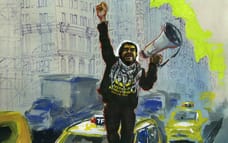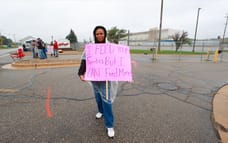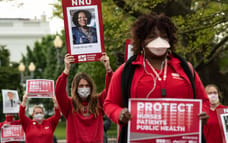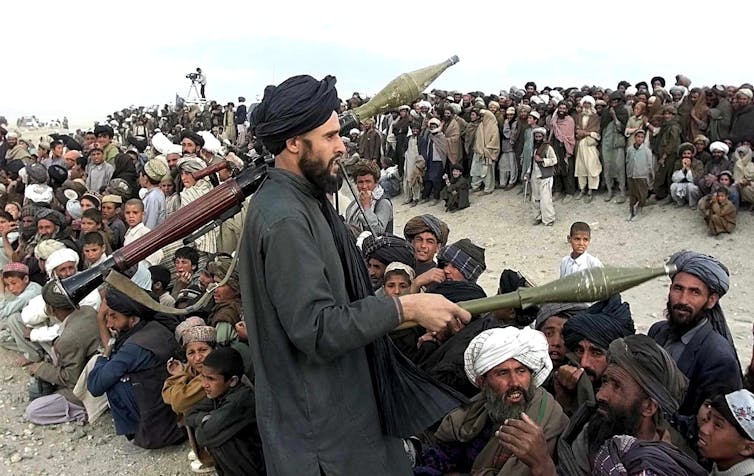
Photograph by Nathaniel St. Clair
The late Pope John Paul II wrote an encyclical in 1996 condemning Western societies for creating and maintaining a “culture of death.” Referring specifically to abortion and euthanasia, the Roman Pontiff wrote, “Choices once unanimously considered criminal and rejected by the common moral sense are gradually becoming socially acceptable.”
When I was studying political science at the University of St. Francis in Joliet, Illinois, during the early 2000s, the Pope’s full-throated excoriation of the West was a routine matter of discussion in theology, philosophy, and political science courses. As a pro-choice leftist, I always took critical aim at the Catholic Church’s position against women’s medical freedom and bodily autonomy, as well as its refusal to support the terminally ill’s right to die with dignity. Despite my disagreements with its application, the simple and brutal phrase, “culture of death,” has never left my memory.
It is now as clear and ominous as a cancer diagnosis that the United States has descended into a “culture of death.” The value of human life has become fodder for partisan debate, and mass fatalities, whether the result of gunfire or widespread infection from a deadly disease, receive blasé shrugs of indifference from the general public. As the American death toll from Covid-19 climbed into the hundreds of thousands (it currently stands at over 800,000), the Republican Party obstructed minimal efforts to reduce loss of life, touting a childlike notion of “freedom” over the safety of human beings. Teachers, workers, the elderly and disabled, and even children were worthy of sacrifice, according to elected officials like Texas Lieutenant Governor Dan Patrick and Florida Governor Ron DeSantis, for the health of the stock market, or the preservation of something called, “the American way of life.” 800,000 Americans cannot enjoy any way of life, nor can they applaud the profit maximization of the rich, because they are dead.
The man most responsible for their deaths – Donald Trump – is currently defeating Joe Biden in head-to-head polls for a 2024 rematch.
The National Center for Disease Preparedness at Columbia University estimated in October of 2020 that between 130,000 and 210,000 Covid-19 deaths were preventable, placing the blame squarely on the negligent and sociopathic anti-testing, anti-mask, anti-mitigation, and misinformation policies of the Trump administration. More recently, Dr. Deborah Birx, who served as the White House Coronavirus Response Coordinator under Trump, joined the Columbia team of researchers by arguing that Trump was responsible for, at least, 130,000 deaths. Citing her own experience at the highest level of the Trump administration, she told the US House select subcommittee on Covid-19 that the former president was more concerned with his reelection than public health; routinely dismissive, if not outright hostile, to the advice that she and other experts dispensed to prevent loss of life.
In a sane society, Birx’s testimony would bring the country to a grinding halt. At a minimum, the political and career prospects of Trump, and his enablers, would undergo absolute demolition. America’s leading institutions would banish Trump, his cabinet members, and adult children far into shame and exile, leaving them afraid to enter public circles. True justice would go further – bringing on legal investigations, as is possible in Brazil, where President Jair Bolsarno might face criminal charges for his Trump-like sabotage of his country’s pandemic response. Americans do not live in a sane society. We reside in a “culture of death.” Signs of it are everywhere, rendering Covid-19 itself, ironically, a symptom of a much larger disease.
Kyle Rittenhouse, vigilante Trump-worshiper, whose mother chauffeured him 20 miles from Antioch, Illinois to Kenosha, Wisconsin, to guard a used car lot with a high powered assault rifle, was acquitted for shooting three Black Lives Matter protestors, killing two of them. The defense’s entire case succeeded on if their insistence that the baby Brownshirt was “acting in self-defense.” Rarely do any commentators outside the courtroom take a moment to ask the obvious: What kind of civilization accepts as normal a teenager having access to a military-style firearm? Even though it is illegal for anyone under 18 to possess such a weapon, Rittenhouse’s lethal capacity is not shocking to anyone. His armed status is so pedestrian that the presiding judge of the case, whose phone blasts the Donald Trump campaign theme song, “God Bless the USA,” dismissed the weapons charge against him. Rittenhouse is not only a free man, while thousands of poor people of color rot in cells for minor crimes, but a right wing celebrity – making the talk show rounds with Tucker Carlson and Charlie Kirk, and scheduled to speak at the comically named, “America Fest 2021,” the annual convention for Turning Point USA, an organization committed to right wing student advocacy with a long track record of racism, extremism, and Islamophobia.
On November 30, 2021, Ethan Crumbley shot 11 of his classmates at Oxford High School in Oxford Township, Michigan, killing four of them. His parents are unlikely to fare as well as Rittenhouse. They are facing charges of involuntary manslaughter for providing Crumbley easy access to a firearm, even after receiving warnings that he was plotting a massacre. The rare turn of justice in the “culture of death” is laudable, but the public and media reaction to school shootings signifies a society with a deep disorder. When the Columbine shooting happened in 1999, the entire country stopped to have debates – some intelligent, some inane – about how such an atrocity could occur, and how to prevent similar mass casualty events from happing again. 22 years later, mass shootings often fail to even make front page news. Meanwhile, millions of Americans, including duly elected members of Congress, treat guns with sick reverence, even posing with them in family Christmas photos.
The glorification of violence is treated as a banality in exact accordance with Pope John Paul’s admonishment that “choices once rejected by common moral sense are gradually becoming socially acceptable.” 72 million Americans report owning a gun, but because it is illegal for law enforcement to keep a firearm ownership registry, the actual number is likely much higher. Although the US accounts for only 4 percent of the global population, its people own 40 percent of the world’s guns. Even Rittenhouse’s surviving victim was armed at the crime scene, testifying that grabbing his gun is like picking up his wallet and phone every morning before he leaves the house. According to the Mass Shooter Tracker Project, 470 mass shootings have occurred in 2021, leaving 482 dead, and 1, 927 injured. No matter how nightmarish a massacre, the American political system will not allow for the passage of more rigid and restrictive regulations on the purchasing and carrying of firearms. Whether it is a sniper shooting down concertgoers from his hotel window in Las Vegas, or a maniac executing schoolchildren in Newtown, Connecticut, Americans react by buying more guns, and stockpiling more ammunition. In the words of a recent Guardian headline, “US gun sales spiked during pandemic and continue to rise.” An instrument of death does not cause alarm in a culture of death
Acts of violence as mechanisms of a white supremacist and fascist ideology are hardly novel in the United States. It is possible to track the entire history of the country with statistics and stories of state sponsored, well-organized, and lone wolf acts of racial terrorism. Currently, the armed madhouse that has become the US is experiencing an explosion of hate crimes. On the rise since 2009, the Anti-Defamation League reports that hate crimes are becoming increasingly frequent and severe against Jewish, Black, Asian, Latino, gay, and trans Americans. The organization, which compiles one of the most sophisticated hate crime databases in the world, also criticizes law enforcement and political institutions for inadequate reporting, investigating, and punishment of said crimes. Using the ADL database, three academics concluded that counties hosting Trump rallies in 2016 experienced a 226 percent increase in hate crimes, most of them targeting – perhaps, by some magical coincidence – the same targets of Trump’s vicious ire: Blacks, Latinos, and trans people. Although the mainstream media regularly reports on hate crime statistics and incidents, the reaction of the electorate, and the Democratic Party that purports to represent the voters who are victims of fascist attacks, is tepid at best. Rather than treating politically targeted violence, and the Republican party that encourages it, as a national crisis, the mainline press prioritizes stories of Britney Spears’ conservatorship, Kayne West and Kim Kardashian’s divorce, and slight jumps in the prices of Christmas presents. Just as a pandemic and mass shootings fail to provoke shock and outrage in a “culture of death,” hate crimes produce a collective yawn – if not fatigue, then outright celebration. Republican Congressman Paul Gosar from Arizona tweeted a cartoon video of him murdering fellow member of Congress, progressive Latina Democrat Alexandria Ocasio-Cortez, only to have almost his entire party defend him against House censure. Depicting the assassination of political opponents now has the sanction of one of America’s two major political parties.
The likelihood of political assassination and terrorism has increased with many sources confirming that school board officials and county election supervisors are under an avalanche of death threats from right wing lunatics who leave screaming voicemails with messages like, “I pray to God, your children die in your face.” Far from a few isolated misfits, leading specialist on terrorism and political violence, Robert Pape, reveals that 21 million Trump supportersclaim they are willing to participate in violence to achieve their ideological ends. As Christian Picciolini, former neo-Nazi and current anti-racist leader, has warned in reference to the legitimation of violence and the rising fascist threat against multiracial democracy, “Everything happening right now is the skinhead’s dream of the 1990s coming true.”
Meanwhile, the political system, like Satan in Dante’s Inferno, is shrouded in an icy circle of hell, unable to escape the cold capitalistic and militaristic “culture of death.” The masochistic Democrats struggle, and will likely fail, to pass the “Build Back Better” agenda of subsidized childcare, paid family leave, and universal pre-kindergarten, while slimy rats like Joe Manchin cite concerns over “inflation” and “deficit spending.” No such concerns apply to the bipartisan Pentagon budget – a $768 billion monstrosity that dwarfs Biden’s moderate social welfare plans. As historians often explain, Republican Presidents, such as Dwight Eisenhower and Richard Nixon, signed budgets with comparatively robust infrastructural and social spending. The “culture of death” has grown so large and dominant that treasure wasted on bombs, fighter jets, and munitions doesn’t elicit a single protest, but mere discussion of allocating resources toward programs and agencies that might improve people’s lives causes panic.
Indifference to the pandemic, insane gun culture, dramatic rise in hate crimes, surge of fascism against America’s already weak democracy, and prioritization of war over everything else are all set against the largest and most significant manifestation of the “culture of death”: ecological destruction and the civilizational threat of a rapidly heating and severely polluted planet.
Proving that the “culture of death” spits its venom throughout the world, many countries have failed to react with necessary urgency and aggression to the escalating crises of climate change, species endangerment, and biodiversity destruction. The United States is the world’s foremost offender, home to many of the worst companies of the fossil fuel industry and a sprawl-automobile society, emitting greenhouse gases at murderous rates. Speaking of murder, the United States military consumes more hydrocarbons than most countries. Other rich and developed nations, such as China, Australia, and the United Kingdom, refuse to significantly alter their commercial activity, even if the entire world hangs in the balance. Humanity has eliminated 60 percent of animal populations since 1970, and Botanic Gardens Conservation International concludes that up to half of the world’s wild tree species are currently at risk of extinction. Doing their best to inculcate the values of a “culture of death,” political leaders at COP26, the United Nations Climate Change Conference, neglected to even discuss some of the world’s most environmentally devastating practices, such as the carbon footprint of the US military, or the deforestation and habitat destruction of big agriculture. The “culture of death” is nothing if not clever. Scientists at the Center for Biological Diversity, in the midst of the Covid-19 pandemic, warn that “wildlife exploitation and habitat loss fuel pandemic risk.” The Center also explains that the US plays a “major role” in the global threat of habitat destruction.
Similar to the collapsing Roman Empire, the US has its own bread and circuses. At the Astroworld Music Festival that took place in Houston, Texas in November, ten concertgoers died due to stampede and riot-like crowd behavior that rapper, Travis Scott, encouraged while performing on stage. Scott, whose resume includes misogyny, homophobia, and celebrations of greed, is notorious for telling his audience to “rage,” “get wild,” and even assault each other. At the November Astroworld festival, even after several attendees sustained serious injuries from crowd crush, other Scott fans danced and blocked ambulances from reaching victims. Even a clever novelist would fail to find a better metaphor for what has become of the United States.
In his 1996 encyclical, Pope John Paul II wrote, “Moral uncertainty can in some way be explained by the gravity of today’s social problems, sometimes mitigating the responsibility of individuals, but it is no less true that we are confronted by a true structure of sin, which takes the form of a ‘culture of death.’ This culture denies solidarity and is fostered by currents that encourage a society that is excessively concerned with efficiency.” He went on to explain that all societies must radically restructure themselves to “promote the respect for life.”
I am not Catholic, and it has been a long time since I sat in Sunday school, but I still remember how to say, “Amen.”
















